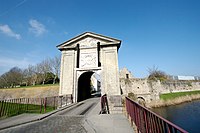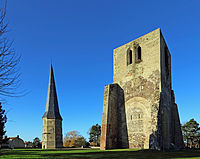Bergues
This article needs additional citations for verification. (January 2017) |
Bergues
(Sint-Winoksbergen) | |
|---|---|
 A street and the belfry of Bergues | |
 Coat of arms | |
show Location of Bergues | |
 Bergues | |
| Coordinates: 50°58′09″N 2°26′06″E / 50.9692°N 2.435°ECoordinates: 50°58′09″N 2°26′06″E / 50.9692°N 2.435°E | |
| Country | France |
| Region | Hauts-de-France |
| Department | Nord |
| Arrondissement | Dunkerque |
| Canton | Coudekerque-Branche |
| Intercommunality | Communauté de communes des Hauts de Flandre |
| Government | |
| • Mayor (2020–2026) | Paul-Loup Tronquoy |
| Area 1 | 1.32 km2 (0.51 sq mi) |
| Population (Jan. 2018)[1] | 3,637 |
| • Density | 2,800/km2 (7,100/sq mi) |
| Time zone | UTC+01:00 (CET) |
| • Summer (DST) | UTC+02:00 (CEST) |
| INSEE/Postal code | 59067 /59380 |
| Elevation | 1–22 m (3.3–72.2 ft) |
| Website | Official website |
| 1 French Land Register data, which excludes lakes, ponds, glaciers > 1 km2 (0.386 sq mi or 247 acres) and river estuaries. | |
Bergues (French pronunciation: [bɛʁɡ]; Dutch: Sint-Winoksbergen; West Flemish: Bergn) is a commune in the Nord department in northern France.
It is situated 9 kilometres (5.6 mi) to the south of Dunkirk and 15 kilometres (9.3 mi) from the Belgian border. Locally it is referred to as "the other Bruges in Flanders". Bergues is a setting for the 2008 movie Welcome to the Sticks (Original French title: Bienvenue chez les Ch'tis).
History[]

The town's name derives from the Flemish groene berg, which means "green hill". According to legend, St Winnoc, son of the Breton king, retired to Groenberg, a hill on the edge of the coastal marshes(see Marcae below). His establishment soon developed into a small monastery.
In 882, when the Normans began their incursions, the Flanders count Baudouin II built primitive fortifications. Later, about 1022, count Baudouin IV built Saint-Winnoc church and interred the relics of St Winnoc there. This church formed the basis of an abbey.
Trade was aided by proximity to the sea, which had not yet receded to Dunkirk, and the abbey. Bergues was chartered in 1240, and its independence was later expressed in the construction of a belfry. It became a port and textile center of regional importance, and part of the Hanseatic League. Its wool market began in 1276 and over the following centuries it was fortified and maintained its independence from France. In 1583, Bergues was besieged and conquered by Alexander Farnese, but king Philip II of Spain allowed it to be rebuilt, establishing the present appearance of the town. Bergues became a major port city and eventually was attached to France by the Treaty of Aix-la-Chapelle in 1668. Louis XIV later developed Dunkirk, and Bergues was eclipsed as a major port. After the French Revolution, its decline continued.
Bergues was devastated by bombardment in World War I, and again in 1940 during the Battle of Dunkirk. The city was entered on June 2 of that year, and 80% of it was ruined during World War II.
Near industrialized Dunkirk, its many monuments are reminders of a rich past, and tourism has been developed in recent years.
Bergues was the setting for the 2008 French film Bienvenue chez les Ch'tis. The film, which broke French box office records, is credited with triggering a tourism boom in Bergues.[2]
Possible Roman influence
There is a possibility of Bergues being the Roman Port of 'Marcae' mentioned in the Litus Saxonicum as there appears to be research in the UK that the high sea levels were about 4.5 metres higher in late Roman times that that of today.
Bergues is about half way between Oudenberg and Boulogne(both Saxon Shore forts) and appears to be land if the sea level is raised 4.5 metres in which case would mean Bergues would have a well protected harbour inland from the town.
Links for this are:
Explanation of sea level rises based on Anglo Saxon village names at 4.5 metres
University of Durham Roman sea levels in the Wash at 4.5 metres
Sea level rises are shown by Scalgo with Sea level rises of 4.5 metres around Bergues
Population[]
| Year | Pop. | ±% |
|---|---|---|
| 1793 | 6,108 | — |
| 1800 | 5,085 | −16.7% |
| 1806 | 5,667 | +11.4% |
| 1821 | 5,528 | −2.5% |
| 1831 | 5,962 | +7.9% |
| 1836 | 5,968 | +0.1% |
| 1841 | 6,045 | +1.3% |
| 1846 | 5,967 | −1.3% |
| 1851 | 5,968 | +0.0% |
| 1856 | 5,665 | −5.1% |
| 1861 | 6,022 | +6.3% |
| 1866 | 5,738 | −4.7% |
| 1872 | 5,774 | +0.6% |
| 1876 | 5,368 | −7.0% |
| 1881 | 5,385 | +0.3% |
| 1886 | 5,435 | +0.9% |
| 1891 | 5,380 | −1.0% |
| 1896 | 5,258 | −2.3% |
| Year | Pop. | ±% |
|---|---|---|
| 1901 | 5,227 | — |
| 1906 | 5,032 | −3.7% |
| 1911 | 4,856 | −3.5% |
| 1921 | 3,922 | −19.2% |
| 1926 | 3,878 | −1.1% |
| 1931 | 3,756 | −3.1% |
| 1936 | 3,839 | +2.2% |
| 1946 | 3,237 | −15.7% |
| 1954 | 3,842 | +18.7% |
| 1962 | 4,469 | +16.3% |
| 1968 | 4,545 | +1.7% |
| 1975 | 4,485 | −1.3% |
| 1982 | 4,488 | +0.1% |
| 1990 | 4,163 | −7.2% |
| 1999 | 4,209 | +1.1% |
| 2006 | 3,959 | −5.9% |
| 2007 | 3,923 | −0.9% |
| 2009 | 3,874 | −1.2% |
| 2012 | 3,910 | +0.9% |
| 2015 | 3,805 | −2.7% |
Heraldry[]
 |
The arms of Bergues are blazoned : Argent, a lion contourny sable langued gules impaled with Argent, a fess sable, and on a canton Or, a lion sable within a bordure gules.
|
Sights[]
- The belfry is the city's most celebrated attraction. Started in the 13th century it was rebuilt after the French invasion in 1383 and again in the 16th century, and restored during the 19th century. Damaged by fire in 1940 and destroyed by dynamiting in 1944, it was again rebuilt in 1961. It was classified as a historic building in 2004 and, as one of the Belfries of Belgium and France, a UNESCO World Heritage Site on 16 July 2005. A carillon of 50 bells sounds for the Monday market and other festivities.
- The ramparts, 5,300 metres (17,400 ft) long, are partly medieval and partly constructed by Vauban.
- The abbey of St Winnoc was destroyed in 1789, and only parts remain: the marble gate and two towers.
Gallery[]

The belfry has a carillon of 50 bells.

The Gate of Cassel, on a triangular pediment, incorporating the radiating sun of Louis XIV.

The church of St Martin.

The Marble Gate, main gate of the former St Winnoc abbey.

The Tour Pointue of St Winnoc abbey.

The Tour Pointue and the Tour Carrée of St Winnoc abbey.

The ramparts, 5300 meters long, have surrounded almost the entire town for five centuries.

Old mount of piety, now municipal museum in Bergues
Canal in Bergues
The Town Hall (mairie) in Bergues
International relations[]

- Twin towns
 Erndtebrück, Germany, since 1973
Erndtebrück, Germany, since 1973
Popular culture[]
The movie Bienvenue chez les Ch'tis (by Dany Boon) is set in Bergues.
See also[]
References[]
- ^ "Populations légales 2018". INSEE. 28 December 2020.
- ^ "French regional comedy breaks box office record". Retrieved 2008-03-09.[dead link]
External links[]
| Wikimedia Commons has media related to Bergues. |
- Communes of Nord (French department)
- Vauban fortifications in France













